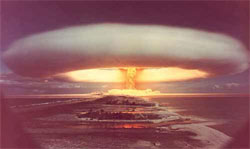|
|

|
|

Nuclear Weapons |
|
By
Webindia123 Editor
17.8.2009
Mail Now
|
Nuclear weapons are the ones which derive its energy from nuclear reactions and possess enormous destructive potential. A nuclear explosion can have a disastrous effect on a potential target. These weapons can be 'Strategic', i.e large weapons used to strike large targets or 'Tactical' i.e sm aller weapons used to destroy specific targets such as a communication or military base.
aller weapons used to destroy specific targets such as a communication or military base.
Technically Nuclear weapons can be either Fission or Fusion devices based on the dominant source of the weapons energy. But in mostly all complex modern weapons, Fission and Fusion devices are combined, so they are generally termed as 'Nuclear Weapons' as both these category of explosive devices release energy from transformation of the atomic nucleus.
Pure fission devices are termed as Atom Bombs or A- Bombs. They derive their energy from nuclear fission, where heavy nuclei such as Uranium or Plutonium are split into lighter elements when struck by neutrons and produce more neutrons which in turn strike other nuclei and so on, triggering a chain reaction. The principal materials used for fission weapons are U-235 (Uranium) and Pu-239 (Plutonium) which are termed as fissile material. The Japanese bombings in 1945, used atomic bombs 'Fat man' with 6.2kg of plutonium to destroy Nagasaki and 'Little boy' with 64.1 g of Uranium at Hiroshima.
Fission weapons use two assembly systems, gun device or implosion. In a gun device, two pieces of the fissionable material are assembled on both sides of a tubular device and they are brought together by shooting one mass at the other mass using a high explosive. In the implosion method of assembly, high explosives or propellants are arranged to form an imploding shock wave which compresses the fissile material to super criticality. In gun devices only Uranium is used, while in implosion method, both Plutonium and Uranium can be used.
Fusion devises are termed as Hydrogen bombs or H-bombs or Thermo-nuclear weapons and they derive energy from nuclear fusion where light nuclei such as Hydrogen and Helium combine together to form heavier elements releasing heavy energy. Deuterium. tritium, lithium7 are other materials used for fusion devices.
Advanced Thermonuclear weapons include a fissionable outer shell of Uranium, which will fission due to heavy energy release of the intense fast neutrons from the fusion stage of fusion materials inside the weapon. Another thermonuclear weapon include Neutron bombs which are small thermonuclear weapons in which the heavy energy released inside by the fusion of the neutrons is not absorbed inside but intentionally allowed to escape through an outer shell made of chromium or nickel.
Effects of Nuclear weapons:
Nuclear weapons are particularly destructive, with immediate effects including blast and thermal radiation and delayed effects of nuclear radiation produced by ionizing radiation, neutrons, x- and gamma rays, electromagnetic pulse (EMP) and radioactive fallout (residual radiation). Effects of each form depends on the design or size of the device i.e the yield of the weapon, the location, altitude and the environment in which the weapon is detonated.
Larger the weapons, the blast and thermal effects are much greater than the delayed nuclear radiation induced by the weapon. Blast and the thermal damages can be as same as any conventional explosive, but the difference is that nuclear weapons can release larger amounts of energy at once.
Blast effects can be ground shock, water shock, large amounts of dust and radioactive fallout. Blast energy of a weapon can constitute 40-50% of the total energy released. This can cause moderate to severe damage to most buildings like any conventional explosive.
The effects of thermal radiation are burns and eye injuries, caused by the large amounts of electromagnetic radiation visible as infrared and ultraviolet light and some soft x-ray emitted at the time of the explosion. This light is so powerful that it can start fires that spread rapidly in the debris left by the blast. The depth of the destructive effect of thermal radiation will depend on the material, its nature, colour, its thermal conductivity and the environmental factors such as a fog which can scatter the light. Thermal radiation can constitute about 30- 50 % of the total energy released after detonation. An enormous fire storm or fire ball developed in Hiroshima 20 minutes after the bomb strike.
At high altitudes, the x-rays ionize the upper air, moving large numbers of electrons. The moving electric charge is powerful enough to destroy unshielded electronic equipments, disrupt radio traffic, satellite to satellite communications etc. High electro magnetic pulse (HEMP) can disable communication systems and even power grids thousands of miles away from the burst.
Nuclear radiation constitute about 15% of the total energy release. It includes 5% initial ionizing radiation consisting mainly of neutrons and gamma rays emitted within the first minute after detonation, and 5-10% as residual nuclear radiation. The intensity of initial nuclear radiation decreases rapidly with distance from the point of burst because the radiation spreads over a larger area as it travels away from the explosion. It is also reduced by atmospheric absorption and scattering.
Radiation effects of a residual fall out are considerably more complex that of the blast or thermal radiation. The hazards are long term due to the accumulation of radioisotopes in the body as a result of ingestion of food or water containing radioactive materials. A range of biological changes can occur ranging from rapid or delayed effects.
Nuclear weapons are more useful militarily than bio chemical warfare where the damage take time to have effect and are unpredictable. Nuclear weapons are expensive to build, maintain, and require a significant fraction of the total defense resources of a small nation to employ them.